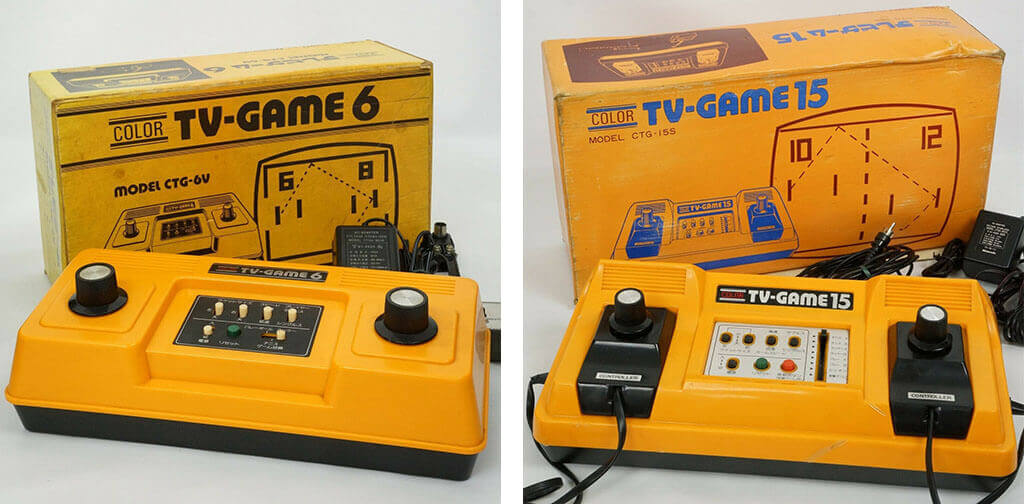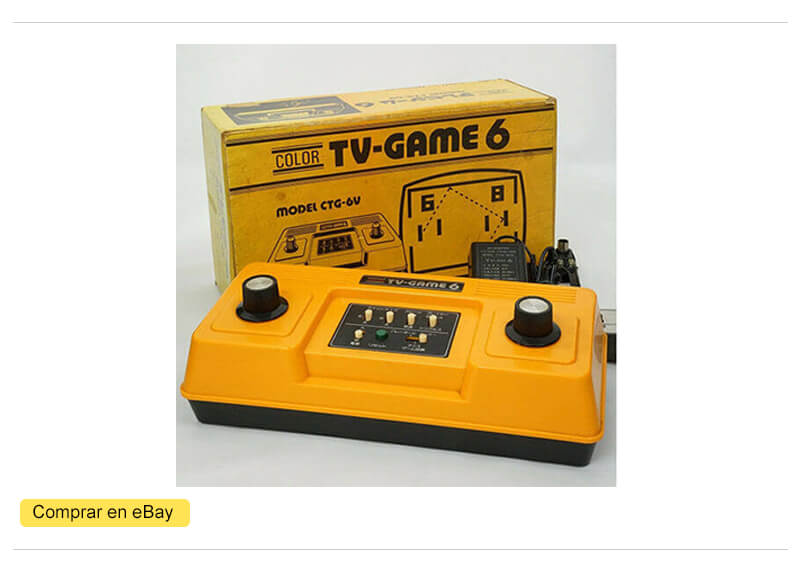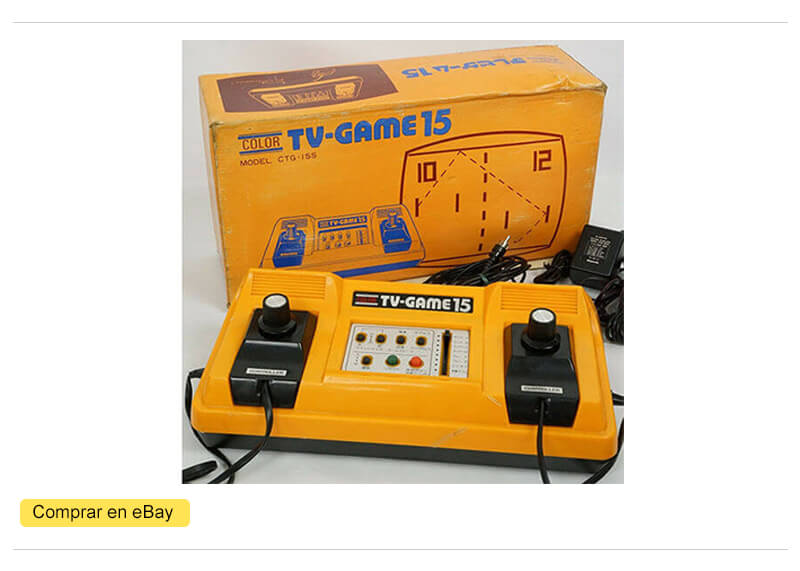The first console of the great Nintendo was actually two consoles: The Nintendo Color TV-Game 6 and Nintendo Color TV-Game 15. Launched in July 1977, Nintendo made the leap to the home video game market and joined the fashion of the first generation PONG type consoles.
The Color TV-Game 6 and 15 are the origin of the Nintendo that we all know: The Big N, the company that has set the pace in the history of video games, exactly since that already distant month of July 1977, with the launch of your first console. Let’s meet the first Color TV-Game, the arrival of Nintendo to our homes.
| COMPANY: | Nintendo |
| CONSOLE GENERATION: | 1ST GENERATION OF CONSOLES |
| RELEASE DATE: | July 1, 1977, Japan |
| GAMES CATALOG: | 6 and 15 depending on the model. |
| SOLD UNITS: | 500.000 Color TV-Game 6 // 900.000 Color TV-Game 15 |
| LAUNCH PRICE: | 9.800 yen Color TV-Game 6 // 15.000 yen Color TV-Game 15 |
| PROCESSOR: | Mitsubishi Electric LSI (no CPU) |
| FORMAT: | Integrated games |
| BUY IT ON EBAY: | https://ebay.us/6Pr476 |
- History of Color TV-Game 6 and Color TV-Game 15.
- Nintendo Color TV-Game 6.
- Nintendo Color TV-Game 15.
- Price of a Color TV-Game 6 and 15 console. How much did they cost?
- Collect the original Nintendo Color TV-Game.
- Buy a Color TV-Game 6 and 15.
- TOP Retro: Best games of the Color TV-Game.
- FAQ Color TV-Game 6 and 15.
Nintendo Color TV-Game 6 and 15, the first Nintendo console
Nintendo is possibly the most important company in the history of video games: arcade machines, Game & Watch, Famicom, Game Boy and a whole series of consoles that in one way or another have contributed to an industry that started with 2 sticks and a ball on the screen, has become what it is today, the most important industry in the entertainment sector above music and film.
Practically all of us know the history of Nintendo since the launch of its well-known Famicom/NES, but this time we are going to carry out an authentic work of digital archaeology, to go back to the true origins of Nintendo in the home video game market with the first two video game consoles from the Color TV Game series.
Background of the Color TV-Game and its context
The history of Nintendo dates back to 1889, the year in which the craftsman Fusajiro Yamauchi founded his company Nintendo Koppai dedicated to the manufacture of Japanese “Hanafuda” playing cards, in the city of Kyoto, Japan. But don’t worry, we’re not going to go that far back, let’s jump back in time to 1969, when we find Hiroshi Yamauchi (Fusajiro Yamauchi’s grandson) as president of Nintendo and a new head of the research and development department : Gunpei Yokoi.
Nintendo had spent years looking for new markets in which to diversify its business, previously hitting the mark in the field of toys with products such as the Nintendo Beam Gun, the Ultra Hand, the Ultra Machine, the Ultra Scope or the Love Tester, all of them designed by Master Gunpei Yokoi (except for Uemura’s Beam Gun). Nintendo consolidated its line of entertainment products and expanded its facilities to launch new entertainment products in which mythical company characters such as Masayuki Uemura, Genyo Takeda and Yokoi himself would work.
In this way, in 1973 they would touch the sky with their expensive virtual laser shooting galleries (projectors) Laser Clay Shooting System, which surpassed bowling in popularity, which had been the star entertainment of the Japanese since the 60’s. Unfortunately, the same year they would go down to hell due to the oil crisis of 1973, in which the Arab countries raised the price of oil in an exorbitant way, leading the population to eliminate unnecessary expenses and Yamauchi canceled this new line of business.
Although the shooting galleries had passed away, their technology could be used in 1974 with the arrival of the first Nintendo arcade games: Wild Gunman, New Shooting Trainer, Skyhawk and Battle Shark. These arcade machines combined the technology of light rifles/guns and 16mm projections, called the Simulation System. Unlike the Laser Clay Shooting System shooting galleries, they were much smaller in size and were designed to be played individually.
With Nintendo already introduced in bowling alleys and halls of electromechanical machines, in 1975 it launched, together with Mitsubishi Electric, the recreational EVR System, arcade machines based on Electronic Video Recorder technology, which replaced the projections with the EVR, its own audiovisual format reproduced on a screen. In practice, these arcade machines worked by placing videos in random order, with players having to guess the order of arrival in EVRRACE, for example, so they were more of a game of chance/bet.
While Nintendo entered the bowling alleys and arcades of the time, the world was undergoing a true revolution thanks to the appearance of video games as we know them. 1972 was the year in which Magnavox launched the first home video game console, the Magnavox Odyssey, and Atari launched its popular Atari Pong arcade game. From that year on, video games would cover more and more of the market, becoming one of the most lucrative businesses.
The process of the arrival of video games in Japan was very similar to that of other North American products, such as electromechanical machines:
- The Americans import a new technology to Japan (initially to its military bases).
- The Japanese adopt it as their own and consume it.
- The Americans set up factories to produce the product in Japan itself (much easier than importing in a protectionist country).
- The Japanese copy the product in their own factories, make it their own, improve it and the citizens prefer it.
This has been the case since the end of the Second World War, transistors, radios, televisions… Dozens of products arrived in Japan through US military bases (first decades), to later make the leap to the general population and be adopted and improved by the Japanese themselves. The arrival and transition of video games in Japan was smooth and natural, the Japanese already enjoyed large entertainment centers full of electromagnetic arcade games from SEGA and other companies, so they understood digital video games as a logical evolution of existing analog arcade games.
A multitude of consoles and recreational ones followed one another, in subsequent years in a continuous evolution and surprisingly good reception by users. From pure clones of the original Pong called Paddle, Tennis or Hockey, the arcades were offering new proposals such as the classic Tank from 1974. A revolution that would not yet reach the domestic markets of the first generation of consoles, taken over by hundreds of consoles type Pong.
Let’s recap (and expand) briefly, so far we have:
- A society that had already embraced American entertainment.
- A buoyant Japanese economy in the middle of the boom of the 70’s, companies raffling off workers and offering them high salaries (due in part to their strict immigration policy). Literally, the companies went to the towns to take the young people to their factories.
- A new entertainment that was sweeping the world, video games.
- North American video game consoles and arcades (largely) being sold all over Japan.
- Japanese managers wounded in their pride to see how the Americans lined their pockets at the expense of their citizens.
- Nintendo in full product diversification.
Contrary to what happened in World War II, this time it was the United States that woke up a giant: The Japanese video game industry. And with it, what would be the most important video game company for many years, Nintendo.
Development and launch of the first two Nintendo consoles
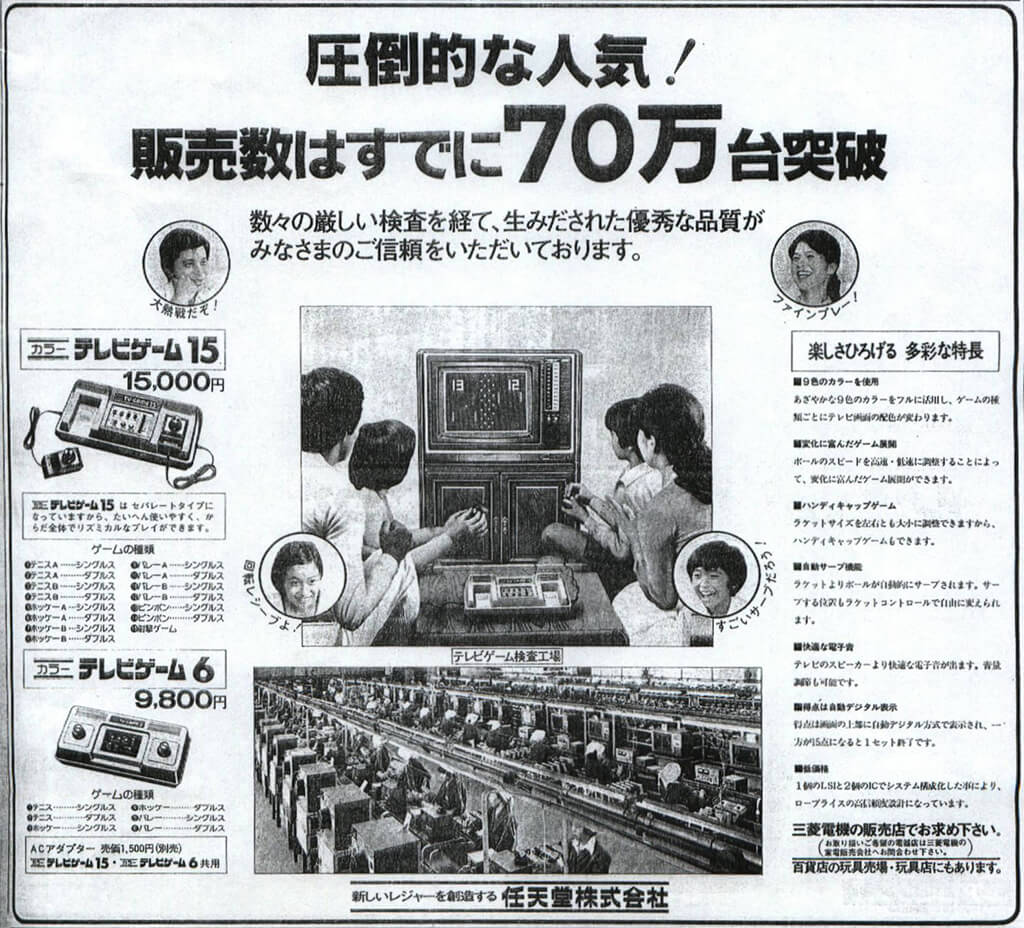
The development of the Color TV Game arose from the failed intention of Mitsubishi Electric Corporation (a company that had previously collaborated with Nintendo, eg EVR) and the calculator company Systec, to create a home video game console, which they had greatly advanced. Systec had developed an LSI based on that of General Instruments and asked Mitsubishi Electric to manufacture it, fortunately for Nintendo in the summer of 1976 the calculator manufacturer Systec went bankrupt, leaving Mitsubishi Electric with an innovative product to manufacture and one less customer. .
But wait... What is an LSI? LSI stands for "Large Scale Integration", that is, "Large Scale Integration", referring to the technology that emerged in the mid-1970s, in which they were able to integrate tens of thousands of transistors on a chip. The first designs of these integrated circuits in the 1970s were designed by hand and were made by specialized professionals together with a team of engineers. These ICs had fewer than 4,000 transistors, and it was not until 1974 that the first 10,000-transistor LSI circuits began to be produced. To give you an idea, an Intel Core i9 9900K (2021) has 3.052 billion transistors.
After Systec went bankrupt, Mitsubishi Electric Corporation came to Nintendo in 1976 and introduced its new LSI, which was capable of reproducing color on TV (something that did not yet exist in the Japanese home market). The question that Mitsubishi asked Nintendo was: Are you willing to market video game consoles? A framing question ladies and gentlemen… Development team engineer Masayuki Uemura, who had come to Nintendo in 1972 from Sharp and had initially assisted master Gunpei Yokoi, had an intuition that it would work.

Masayuki Uemura presented the project to Nintendo president Hiroshi Yamauchi with the intention of developing a home video game console immediately. Hiroshi Yamauchi accepted the proposal with one condition, the console had to cost less than 10,000 yen. From that moment on, Masayuki Uemura and his team worked together with Mitsubishi Electric engineers to develop what would be the first console in Nintendo’s history, the Color TV-Game.
The development of the console was fast, but instead the big obstacle was the condition of the president Hiroshi Yamauchi to limit the price of the console to 10,000 yen. This condition came from the previous successes that Nintendo had had in the field of toys designed for all audiences, from an economic perspective. In other words, Hiroshi Yamauchi thought that for a children’s or entertainment product to be successful, it had to be accessible to the general public. On the other hand, Hiroshi Yamauchi knew that Nintendo was a latecomer to the video game console market, so it could only enter at a very aggressive price.
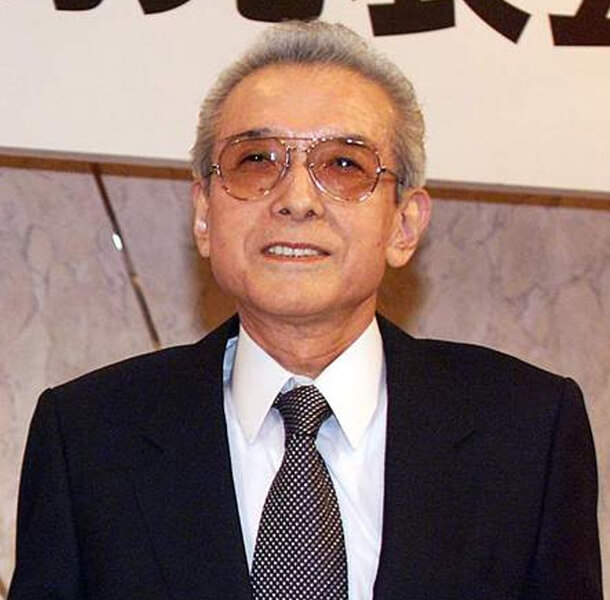
Uemura and Yamauchi had numerous meetings in which Uemura tried to explain to him that it was impossible to lower production costs to that point, even selling 1 million units, with Uemura managing to make a profit by supposedly launching the console at a price of 15,000 yen, but Yamauchi he was uncompromising… So Uemura had to apply lateral thinking and devise an innovative business strategy that would enjoy the approval of Chairman Yamauchi:
The business strategy: Instead of releasing one video game console, Nintendo would release 2 identical inside (LSI) consoles with exactly the same features, but one of them would be limited with fewer features, both in games and devices. In this way, Nintendo would launch the Color TV Game 15 for 15,000 yen, which would have 15 games and removable controls with cables, while launching the Color TV Game 6, for 9,800 yen with 6 games and controls embedded in it. console. The idea was that the Color TV-Game 6 and its low price would serve as a commercial claim to attract the public, and once in the store, when comparing it with the Color TV-Game 15 and its benefits, they would decide on the latter. . Yes, that hard and that bright. Both consoles were the same system, but the Color TV Game 6 was cast to serve as a pure claim. An announcement console.
On July 1, 1977, Nintendo launched its first two video game consoles in Japan, the Color TV-Game with its daring commercial strategy… And it was a success, the plan worked for them and while the two Nintendo Pong consoles were in the In the Japanese market, the estimate is that the Color TV Game 6 sold 500,000 units, while the Color TV Game 15 sold 900,000 units. But Nintendo had achieved much more than good sales in the land of the rising sun:
By putting such a low starting price (10,000 yen), it made many Japanese companies that intended to enter the first-generation video game console market back off as they were unable to launch their products at a competitive price. Nintendo’s strategy worked in a double way since, in addition to good sales, they managed to reduce the competitors present in the new market for PONG consoles.
But still, Nintendo was a latecomer to the home console market, the Magnavox Odyssey had been released in the United States in 1972, and in Japan, Epoch Co had licensed the Magnavox technology to release on September 12, 1975. the first Japanese home console, the TV Tenis Electrotennis a dedicated Pong-type console that was sold for 19,500 yen, which sold more than 10,000 units. TV Tennis Electrotennis was followed by the Epoch TV Game System 10, released in 1977 for 15,500 yen, which came with a beam gun/rifle and an assortment of PONG variants. Were they competition for Nintendo?
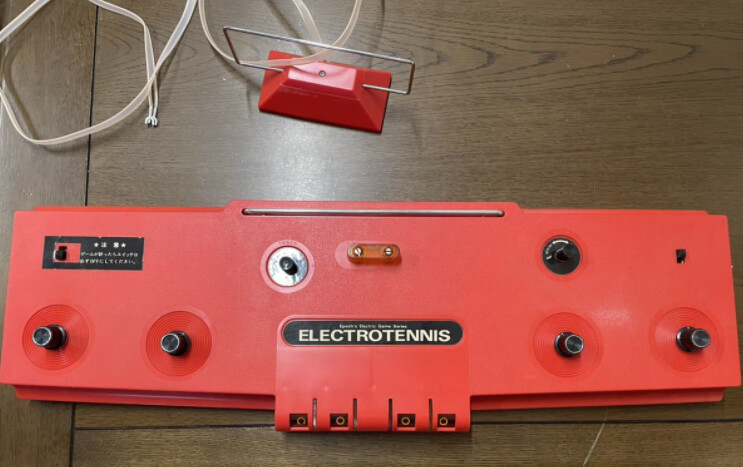
No the truth is no. The case of TV Tennis Electrotennis was a clear reference in terms of price and market knowledge, but by the time Nintendo launched its consoles two years later, technological evolution was very evident, an example being the fact that the Epoch Co console was even It had a points counter, so it had an analog dial built into the console itself. Regarding the rest of the competitors, Nintendo’s 9,800 yen was too powerful a claim, capable of capturing the attention of any player, an impressive figure… It really was a studied figure that made the difference (and the deficit).
This does not mean at all that Nintendo had a path of roses, although it is true that Epoch was initially its main competitor, many other companies such as Bandai or Tommy would end up joining the new home video game market, entering a price and technological war. which would last until the arrival of the Famicom in 1983.
Nintendo Color TV-Game 6
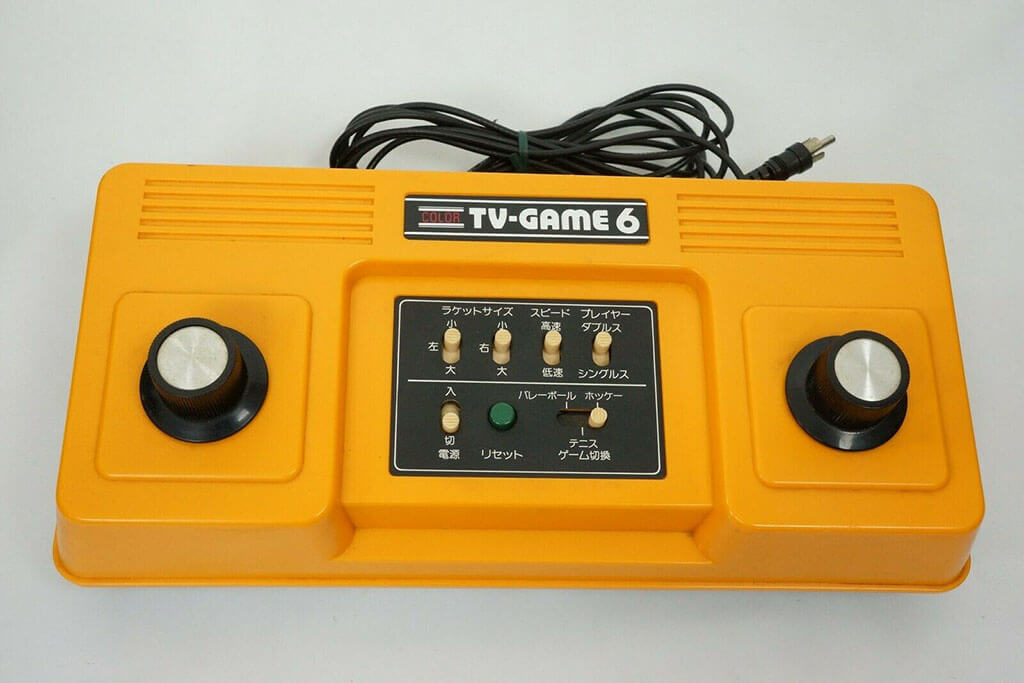
The Nintendo Color TV-Game 6 is a dedicated PONG-type console from the first generation of consoles, that is, all its games are variants of what is popularly known as Atari’s PONG and all its games are integrated into the machine (dedicated console), not There are no cartridges or any other video game format. The console can work with 6 type C batteries or a CTGA-901A model adapter (compatible with the other Color TV Games), which was sold separately for 1,500 yen.
Initially developed as we have already mentioned by Systec and Mitsubishi Electric, the console is licensed by Magnavox, inventors of home video games and whose license fits perfectly with the product released by Nintendo. Its starting price of 9,800 yen, being the cheapest on the market, offered exactly what a large part of the Japanese public was looking for: An inexpensive entry into the new universe of video games.
The 6 games of the Nintendo Color TV-Game 6 were:
| Hockey | Individual | Double |
| Voleibol | Individual | Double |
| Tenis | Individual | Double |
Yes, I know, there are 3… But in those days they sold like 6 games (if you don’t like it, wait until you see Color TV Game Racing 112). All the games are variants of Pong and logically, depending on the game mode, one or two controllers (wheels) are used. But don’t worry, to these 3 games we must add the different options that the console offered us through its upper central switches: Select the size of the blade of the left or right control (large or small) and the speed of rebound of the ball, functions that they increased replayability and enabled asymmetric multiplayer (in 1977).
During its first year, 5 models of Color TV Game 6 were launched, three manufactured by Nintendo (one licensed) and two manufactured by Sharp, a television manufacturer that bought the license from Nintendo to sell the consoles together with its televisions and with which Nintendo would collaborate for many years. Let’s see the different models of the Color TV-Game 6:
- Color TV-Game 6 CTG-6S: The first model of the console is distinguished by the white color of the casing. It does not have an AC input.
- Color TV-Game 6 CTG-6V, with the difference of being orange, is aesthetically very similar to the CTG-6 model, offering numerous advantages over it: Its controls (wheels) are larger, thus offering a better grip, includes a “barrier” on the edges of our screens for the blades, in the previous model the blades passed from one side to the other, now the physics of the CTG-6V are more in line with reality. As a highlight, the possibility of connecting the adapter to power is included.
- Color TV-Game 6 House Shanmen: This limited version of the Shanmen noodles is one of the most difficult to obtain. It is identical to the CTG-6V, differing only in the front plate, which instead of Color TV Game 6 says “House Shanmen” in Japanese. It is estimated that between 1,000 and 5,000 units were manufactured.
- SHARP Color TV-Game XG-106: Sharp’s equivalent to the Color TV-Game 6 CTG-6S, exactly the same except for a stronger orange casing color than the 6V, plus “SHARP” branding on the front of the the console and delete the number 6.
- SHARP Color TV-Game XG-106V: Sharp’s equivalent to the Color TV-Game 6 CTG-6V, exactly the same except for a stronger orange casing color than the 6V, plus “SHARP” branding on the front of the the console and delete the number 6.
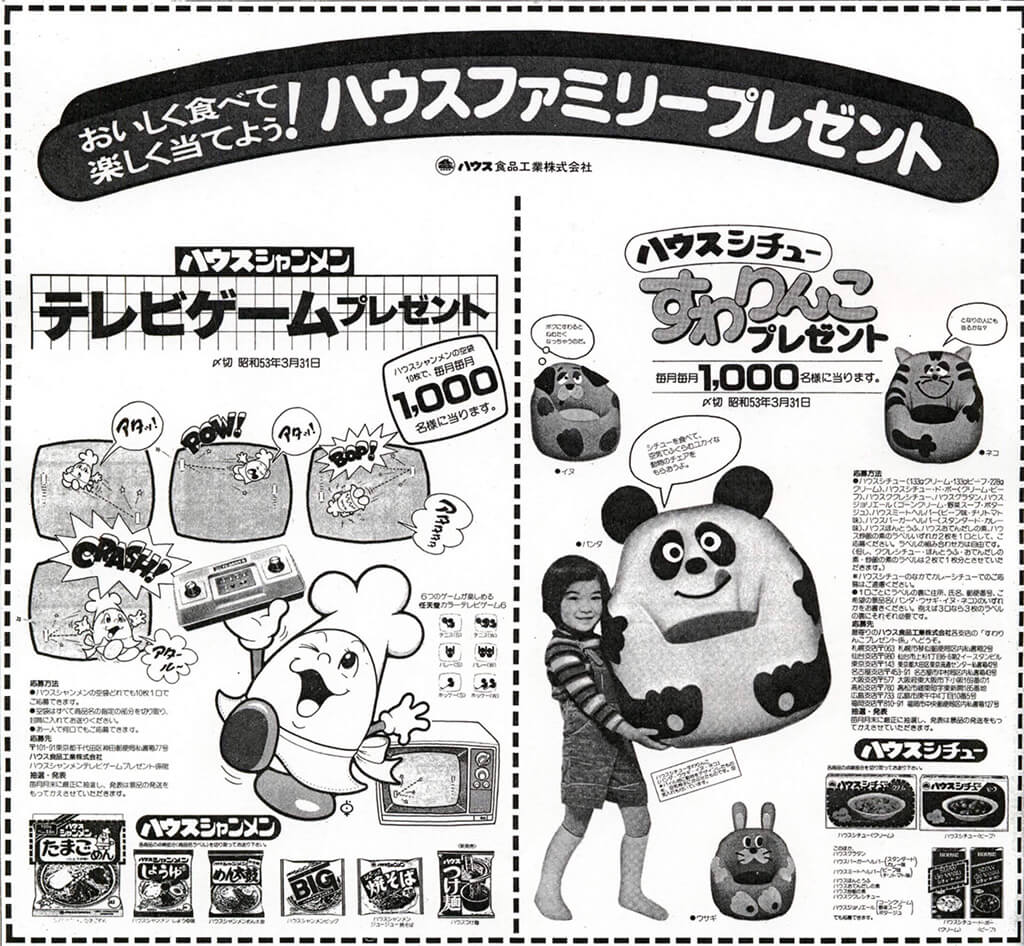
RETRO CURIOSITY! The most observant of you will have already noticed, in the retro Color TV-Game consoles the name of Nintendo did not appear anywhere. The reason? At that time the Nintendo brand did not have as much prestige as it does today, so the Kyoto company decided to create a new exclusive video game brand, enhancing the Color TV-Game image on its machines. Unlike today, in those years the important thing was not the brand, but the product.
Nintendo Color TV-Game 15
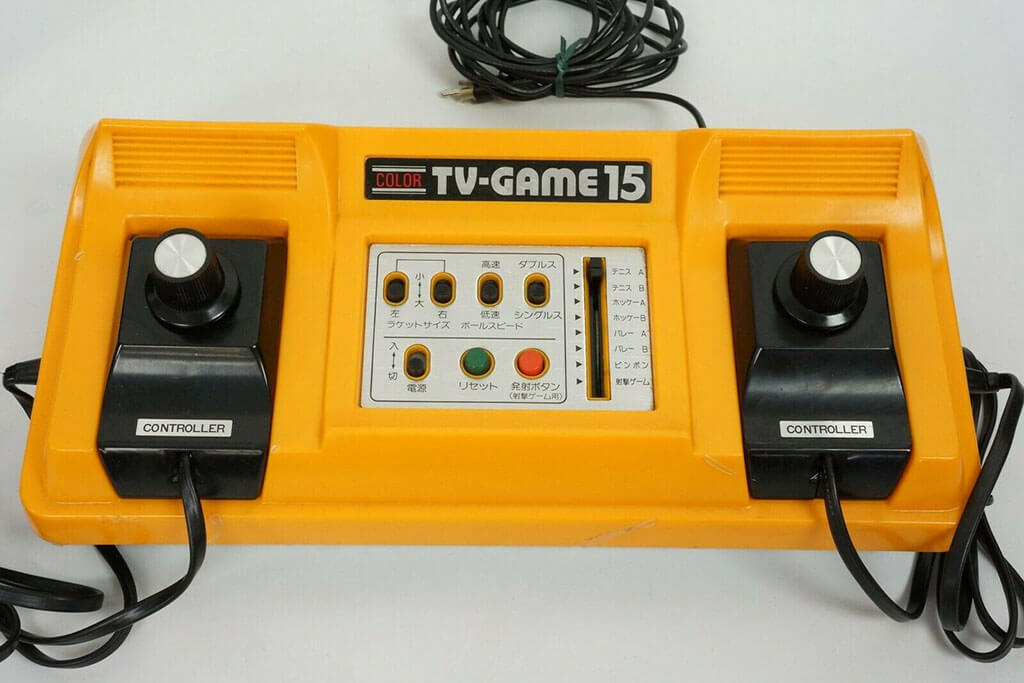
The Nintendo Color TV-Game 15 is the main PONG-type dedicated console of the first generation of consoles, all its games are variants of the well-known PONG and all are integrated into the console itself. It consists of obvious improvements over the Color TV-Game 6 such as its two removable controls (90 cm cable) and its 15 games. The console works with 6 type C batteries and the CTGA-901R power adapter, which was sold separately for 1,500 yen and is used for the entire line of Color TV-Game consoles.
Initially, Nintendo had planned to launch this model alone, but its high price forced it to launch a cheaper version (TV-Game 6) as a claim. Being the same console inside as the TV-Game 6 without any limitations, the Color TV-Game 15 was also initially developed by Systec and Mitsubishi Electric. Its starting price was 15,000 yen, thus offering a much more complete product than its little sister.
The 15 games in the Nintendo Color TV-Game 6 were:
| Hockey A | Individual | Double |
| Hockey B | Individual | Double |
| Voleibol A | Individual | Double |
| Voleibol B | Individual | Double |
| Tenis A | Individual | Double |
| Tenis B | Individual | Double |
| Ping Pong | Individual | Double |
| Juego de disparos |
The difference between game modes A and B is the shape of the center line, which substantially modifies the game conditions. All Pong-type games can be played in single or double mode, considering different games: 7×2 + Shooting Game = 15 games, that’s how it started… The shooting game is the only one that cannot be enjoyed in doubles. Like its little sister, the Nintendo Color TV-Game 15 has a series of modifiers such as bounce speed and blade size, which improve the gameplay of the system.
There are 3 models of the Nintendo Color TV-Game 15 retro console:
- Color TV-Game 15 CTG-15S: First model of the console manufactured by Nintendo in a light orange color and “infinite” controllers, that is, the wheel had no stop.
- Color TV-Game 15 CTG-15V: Second model of the console manufactured by Nintendo with a darker orange color. The “infinite” controls are corrected by increasing the size of the wheel (better grip) and putting a stop, which improves the gaming experience. This was the most manufactured model.
- SHARP Color TV-Game XG-115: Sharp also had its own TV-Game 15, the CTG-15V model being licensed from Nintendo. The Sharp console is identical to the Nintendo console with the only two differences being the white color of the casing and the labels on the front of the console and the controls.
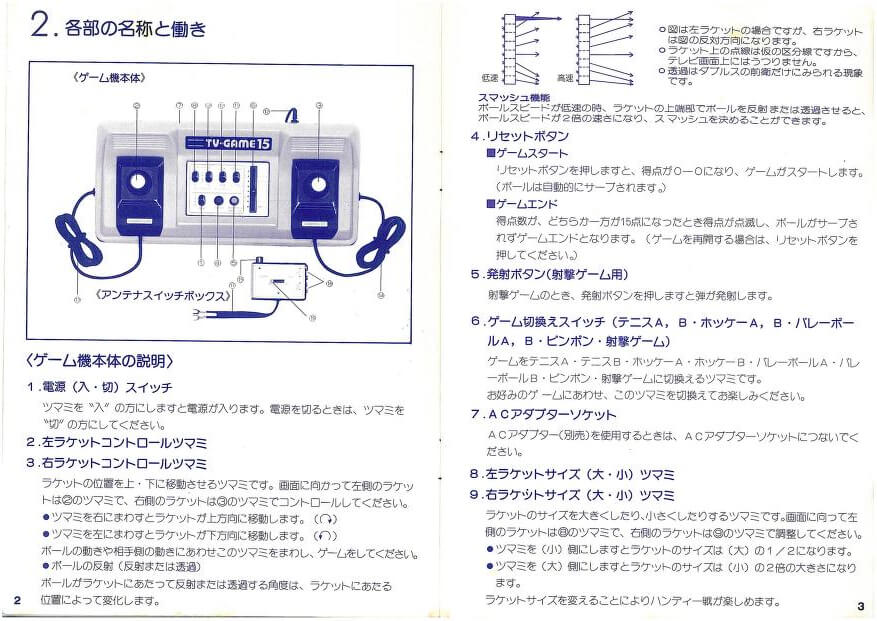
Legacy of the first Nintendo consoles
I think we’ll all agree that the most important thing about Color TV-Games isn’t the consoles themselves, but Nintendo’s entry into the home video game market. Nintendo spent the second half of the 1970’s manufacturing and launching its range of Color TV-Game consoles:
- Color TV Game 6.
- Color TV Game 15.
- Color TV Game Racing 112 (1978), a console with steering wheels, 2 controllers, and 112 video game variants.
- Color TV Game Block Kuzushi (1979), a more than successful Atari Break Out “versioned” by Nintendo (Arkanoid for the youngest).
To this series of consoles we must add Nintendo’s Computer TV Game, a console dedicated to Othello launched in 1980, which was a resounding failure. These were the most unknown beginnings of Nintendo in the world of video game consoles, 5 systems launched in 3 years, not bad to begin with…
After the Computer TV Game would come the Game & Watch and in 1983, Nintendo would conquer the world with its Famicom, the most advanced machine at the time of its launch and one of its greatest successes, later making the leap to 16 bits with its Super nintendo. None of this would have been possible without the path previously traveled by Nintendo with these first machines, the Color TV-Game together with its arcade machines, were and are the foundations of the entire empire that Nintendo represents today. Could there be a better legacy in the history of video games?
The price of the retro console Color TV-Game 6 and Color TV-Game 15
Yes, at Infoconsolas we are always talking about the prices of consoles and video games, but when we talk about first-generation retro consoles, we are well aware that simply saying a figure in yen does not help much. In order to fully understand what 15,000 Japanese yen meant at the time, here is a contextualized list of the different console releases with their corresponding prices so you can compare.
| CONSOLE | LAUNCH | PRICE | BRAND |
| TV Tenis Electrotennis | 1975 | 19.500 yen | Epoch |
| TV Game System 10 | 1977 | 15.500 yen | Epoch |
| Color TV Game 6 | 1977 | 9.800 yen | Nintendo |
| Color TV Game 15 | 1977 | 15.000 yen | Nintendo |
| TV Jack 1000 | 1977 | 9.800 yen | Bandai |
| TV Jack 5000 | 1978 | 19.800 yen | Bandai |
| Color TV Game Racing 112 | 1978 | 18.000 yen | Nintendo |
| TV Baseball | 1978 | 18.500 yen | Epoch |
| Color TV Game Block Kuzushi | 1979 | 13.500 yenes | Nintendo |
| Super Vision 8000 | 1979 | 59.800 yenes | Bandai |
| Computer TV Game | 1980 | 48.000 yenes | Nintendo |
This is a small sample of how the landscape of home video games was in Japan during the first generation of video games until the arrival of the second generation and the adoption of cartridges by consoles such as the Super Vision 8000.
We can verify that, although Nintendo appeared with a groundbreaking price, in no case did it have a path of roses, since companies such as Epoch and Bandai, among others, continued to launch consoles at very competitive prices. They were years of great technological advances and a few months were enough for new systems to become technologically obsolete in the face of new releases.
The first two Color TV Game fulfilled their objective, establishing themselves in a new market and consolidating a new and powerful image and brand with the rest of the Nintendo consoles. The Color TV games were happening until the arrival of the Computer TV Game, an arcade dedicated to Othello inserted in a home console at an exorbitant price, a real failure before the real success of Nintendo: The Famicom of 1983, but that… it’s another story.
Before continuing, if you like the analysis, don’t forget to visit Infoconsolas’ Twitter! You will find a thousand curiosities and much, much retro.
Collect retro Nintendo Color TV-Game 6 and 15 console

Is the original Nintendo Color TV-Game 6 and Color TV-Game 15 worth collecting? Yes, without a doubt, I am going to be very clear on this point: Whether you are a collector of consoles and retro videogames, a next-gen gamer, a casual gamer, a tightrope walker or a baker, your mission in life should be to get one of these wonders, in any of its versions but at least one Color TV-Game 6 and one Color TV-Game 15. It’s that simple.
Exaggerated? Perhaps, but if you are a collector or a fan of retro video games, you should be thankful for coexisting in space and time with these wonders, pure video game history, the pillars on which Nintendo built everything we know. Exaggerating again? Nooop, not at all, at the end of 2021 we have the great fortune to get a console like these for a much lower price than other current systems, at the precise moment that I write these lines for 150 euros, systems working with a box are sold on eBay, separate shipping costs. Thanks God.
At a time when certain Nintendo 64 games pay outrageous amounts such as 8,000 euros, years in which retro is fashionable and its price increases year after year until it reaches ridiculous figures, in these current times, when the market and speculators have not yet discovered or exploited the first Nintendo consoles, it is a true miracle. Yes, I know that the market is nostalgic and they never left Japan, but give them a few years and you will see what prices these consoles reach.
Buy an original Nintendo Color TV-Game
From what was said in the previous section, you can already imagine that for our part, at Infoconsolas we have no doubt that any self-respecting collector needs to have the first two Nintendo Color TV-Game consoles in their collection.
As we always recommend, so far the best place to buy such old and specific systems is eBay, where we can see the consoles available around the world. The following banner will take you to a list of Nintendo’s Color TV-Game consoles, where you can see the current prices of both the retro TV-Game 6 and 15 consoles, as well as the rest of the TV-Game family. Take a look at the prices and then come back before you buy!
What do you think? As you may have seen, for the importance and transcendence of the consoles that we are dealing with, the prices are well below other much more modern and less important consoles in the history of consoles (end 2021). Now, the fact of being a product released only in Japan has positive and negative aspects: The Japanese tend to take good care of their systems, but unfortunately, the prices of shipping costs skyrocket. A reality for which it will be necessary to go looking for the most acceptable prices.
And this is when I normally remember the advice of all good collectors, patience, study the market to know the prices, more patience and buy at a price that we consider appropriate depending on the use we want to give the system… But this time we must consider a new alternative: Japanese JUNK consoles, consoles that have not even been tested in Japanese second-hand stores, most likely not working, but… Much cheaper.
The approach is as follows: Are you going to play with your Nintendo Color TV-Game or are you going to have it on the shelf to admire it? If your intention is to buy a Color TV-Game to watch it, you should seriously think about buying a Junk console or one that doesn’t work directly, you will save a lot of money and the use you will give it will be the same. Pure reality.
STOP COLLECTOR! If you’ve seen the console listing on eBay, I want to say THANK YOU. Since 2004, the objective of Infoconsolas is to contribute to preserving the history of consoles and video games through our own collection of systems and the hours of work invested in this very website.
Being an eBay partner listing, if you buy a game or console, you will be helping Infoconsolas in the preservation of video game culture, so thank you very much again!
TOP: Best console games Color TV-Game 6 and 15
As we have already mentioned, the first two consoles in the history of Nintendo are dedicated, that is, they do not have any format, with 6 or 15 video games integrated into the machine itself. Consequently, in this classic section of Infoconsoles, the question we should ask ourselves is:
The gaming experience, are the first Nintendo Pong consoles playable?
Let’s see the Color TV-Game in motion before judging.

After this nice announcement in which you have been able to, I will give an answer in the form of a script:
- Young boys: David, David! Is Color TV Game 6 playable today? - Me: Nop. - Young boys: And the Color TV Game 15? - Me: Nop. - Young boys: But if it is in color and it looks very fluid! - Me: Nop. - Young boys: But if they are from Nintendo! And oranges! - Me: Nop. - Young boys: But... - Me: Nooooop.
And it is that, unless you are over 50 years old, you have lived in Japan in the 70’s and you have a lot of nostalgia in your veins, the first Color TV Games are not playable for players who started from an Atari 2600 , ZX Spectrum, NES or other systems onwards. It’s that simple, the Pong formula is not enough for our generations, you can play for a while but that’s it, better on the shelf.
Is that negative? So it’s not worth buying? Not at all, these consoles are already part of the history of video games, museum pieces that we must preserve, observe and what the hell, adore every morning when we wake up… But not play on a daily basis. Taking it out one day to give us the pleasure of playing a little game is fine, but that’s it, to play Pong we have many other options, the Color TV Game 6 and 15 have already passed that video game phase and now it is up to them to be in the best place of our collection, where they are seen the most but not touched. They are living history of video games, let’s treat them as they deserve.
FAQ Nintendo Color TV-Game 6 and Color TV-Game 15
Here you have the most frequent curiosities, questions and answers of the Nintendo Color TV-Game 6 and Nintendo Color TV-Game 15 retro consoles, little by little we will expand this section:
On July 1, 1977.
First generation PONG type console.
No, it is exclusive to Japan.
500,000 units of the Color TV Game 6 model and 900,000 units of the Color TV Game 15.
You can find a boxed unit in decent condition for around €120 plus shipping (Nov 2021).
Color TV-Game 6 and Color TV-Game 15 were released on the same day.
The launch price was 9,800 yen for Color TV Game 6 and 15,000 yen for Color TV Game 15.
Yes, mainly the Color TV Game 6, being at half the price of its most direct competitor.
Those that came integrated, 6 and 15.
Integrated games.
Yes, Sharp released their own (identical) models, as well as limited versions like the Color TV Game 6 from noodle brand House Shanmen.
Yes, with 6 LR20 size batteries (9 hours of play) or with a power adapter from the second revision.
29 cm × 14 cm × 8 cm.
21 cm × 15 cm × 10 cm
Yes, Nintendo licensed it from Magnavox. Years later, with other systems they would be seen in court.

